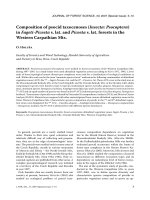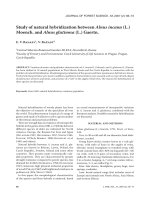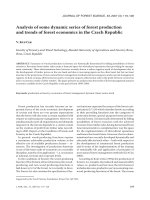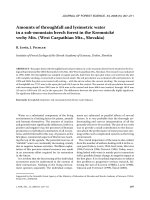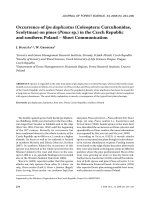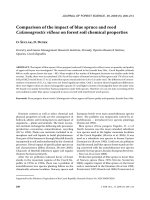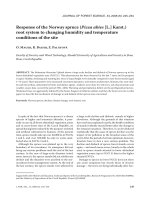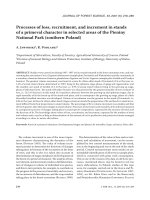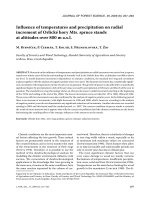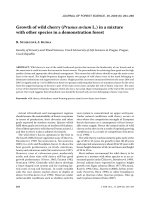Báo cáo lâm nghiệp: "Germination of acorns and development of oak seedlings (Quercus robur L.) following flooding" pot
Bạn đang xem bản rút gọn của tài liệu. Xem và tải ngay bản đầy đủ của tài liệu tại đây (233.05 KB, 9 trang )
J. FOR. SCI., 53, 2007 (9): 391–399 391
JOURNAL OF FOREST SCIENCE, 53, 2007 (9): 391–399
Reconstruction of the Rhine River along the border
between France and Germany in the last century has
aggravated the flooding regime in the upper reaches
of the stream (P 2002) and significantly reduced
the predictability of floods (MU-RP 1993). At many
recording points the frequency of peak flooding
events (average return time) has been reduced by
a half. Consequently, refuges of mature floodplain
forests as well as intensively managed forests along
the river have been affected by more frequent as well
as more severe floods (B 2002; S
2002).
Quercus robur occurs naturally in hardwood
floodplain forests along Central European rivers
(O 1992; S 1994). e broad-
leaf tree species is highly tolerant to flooding and
exhibits optimal growth on floodplains (R,
B 1992; E 1996). Investigations by
S (1988, 2002) after severe floods of the Rhine
in 1987 and 1999 suggested that Quercus robur was
one of the floodplain species best able to withstand
the impact of flooding. On both occasions mature
Quercus robur stands were flooded for more than
100 days on extreme sites. No withering or dying
individuals were observed in the autumn thereafter
(1987) and in the following year (2000), respectively.
Depending upon the speed of the river, pole-sized
regrowth stands withstood the floods for 41 to
55 days without damage.
Young Quercus robur plants were also found to be
flood tolerant. In trials with waterlogged soil in the
rooting zone, Quercus robur seedlings exhibited the
least change in growth in comparison with other oak
species (C-B et al. 1991; D 1994;
S, T 2000). L et al. (1986) and
D et al. (1991) demonstrated that the extent
of the unsaturated soil layer above the water table
influenced the sensitivity of waterlogged Quercus
robur seedlings considerably. Biomass and plant
height, as well as CO
2
assimilation rates and stomatal
conductance decreased significantly with a rising
water table. In a similar study with waterlogging in
the entire rooting zone a considerable leaf loss in
Quercus robur was only observed after 11 weeks and
live plants were found even after 14 weeks (R,
B 2002). Under the aforementioned conditions
Germination of acorns and development of oak seedlings
(Quercus robur L.) following flooding
C. K, N. B
Department I: Silviculture of Temperate Zones and Forest Ecology, Institute of Silviculture,
Georg-August-University of Göttingen, Göttingen, Germany
ABSTRACT: Seeds and seedlings of Quercus robur, a characteristic tree species of the hardwood floodplain forests along
the Rhine River, demonstrated high resistance to complete inundation under controlled conditions. In both experimental
trials no significant difference between the different flooding periods (8, 10, and 12 weeks) could be established either for
shoot emergence or for the measured morphological growth parameters. Flooding delayed the germination of submerged
acorns till the end of inundation. However, seeds of the flooding treatments had significantly higher germination rates
than the non-flooded acorns of the control. Likewise, dry weights of seedlings from the flooded seeds were significantly
higher than those of seedlings from seeds not flooded. Aboveground growth in the 24-week growth period following
flooding was reduced in favour of root development in either trial of the experiment. Restricted leaf development and
reduced shoot elongation stalled the growth of young oaks in the seedling trial. e results confirm knowledge from
earlier experiments about the flood tolerance of Quercus robur seed and seedlings. ey also serve to explain why oak
seedlings are widespread on the Rhine floodplain after mast years, but gradually disappear in successive years.
Keywords: inundation; experiment; mortality; morphology; recovery; pedunculate oak
392 J. FOR. SCI., 53, 2007 (9): 391–399
Quercus robur revealed the least damage out of the
six tested broadleaf tree species, demonstrating the
best adaptation to flooding stress.
In spring 1999, the meeting of flood waters from
the Rhine and many of its tributaries along the up-
per part of the stream resulted in the worst flood of
the last century. e extreme rise in the water level
was caused by unusually mild and wet weather in the
northern Alps. In the course of this event K et
al. (2005) observed high mortality and growth inhi-
bition of Quercus robur grown from direct seeding
and nursery plants at study sites situated between
Speyer and Karlsruhe (Germany). In the experiment
presented in this paper flood conditions of 1999 were
simulated when acorns and seedlings from Quercus
robur were entirely submerged under controlled
conditions in growth chambers and germination
of seeds and regeneration capacity of seedlings fol-
lowing flooding were investigated. Based upon field
observations the following hypotheses were tested
in this work:
– Seeds begin to germinate only after flooding.
– Germination rate decreases as the duration of
inundation increases.
– Inundation during the vegetation period results
in leaf abscission and necrosis of the shoot.
– Mortality of seedlings increases as the duration of
inundation increases.
MATERIAL AND METHODS
Seeds
Seeds were collected in a single-layered mature
Quercus robur stand in southern Rhineland-Palati-
nate (Bellheim Forest District, Germany) in October
1999. e stand is subjected to annual floods from
the Rhine River. Seeds were stored at 4°C until sow-
ing. Prior to the commencement of the experiment,
acorns with reduced germination capacity were re-
moved by the floating test (H 1984) and the
vigorous seeds were surface sterilised in an ethanol
bath (60% solution). At the end of November 1999
the seeds were randomly divided between the experi-
mental treatments.
Sowing
Acorns from all treatments were placed individu-
ally into GL-II plant pots (diameter 5 cm, pot volume
270 cm
3
) and pushed gently into the soil. e GL-II
plant pots were filled with a soil substrate typical of
the Upper Rhine floodplain. e sandy loam silt was
sterilised with steam. Soil properties are presented
in Table 1.
Growth chamber conditions
All experimental treatments were carried out in
growth chambers (Weiss system) at the Institute of
Silviculture, Göttingen University. HQL 400 light
sources (42,000 lm, 3,700 K) produced a constant
photosynthetic photon flux density (PPFD) of
4.3 mole/m
2
/day during the daily 14 h light period.
is light intensity corresponds to a relative light
intensity of about 15% of full sunlight. According
to L (1998) this radiation level, found under-
neath the canopy of lightly thinned floodplain for-
ests (K et al. 2005), is the minimum required
for the satisfactory growth of Quercus robur. Plant
pots were regularly watered to replace the loss from
evapotranspiration determined by weighing during
the growth period of all treatments in both experi-
mental trials.
Seed trial
400 GL-II plant pots each containing one sound
acorn were randomly divided between four treat-
ments:
– C
: control without inundation, 24-week growth
period.
– S8
: 8-week inundation followed by a 24-week
growth period.
– S10
: 10-week inundation followed by a 24-week
growth period.
– S12
: 12-week inundation followed by a 24-week
growth period.
Plant pots of the flooding treatments S8, S10 and
S12 were completely submerged in rain water. To
simulate averaged conditions of the spring flood in
April 1999, air and water temperatures were set to
11°C. During the experiment pH-value and oxygen
Table 1. Substrate properties
pH (H
2
O) 7.8
pH (KCl) 7.3
C/N 23.7
Carbon
organic
(%) 6.8
Nitrogen (%) 0.3
Phosphorus (%) 0.6
Cation exchange capacity
total
(mmol
c
/kg) 285.9
Exchangeable Ca (mmol
c
/kg) 209.6
Exchangeable K (mmol
c
/kg) 3.6
Exchangeable Mg (mmol
c
/kg) 17.2
Exchangeable Na (mmol
c
/kg) 1.3
J. FOR. SCI., 53, 2007 (9): 391–399 393
content of the water were continuously controlled.
Due to the basic soil substrate used in the plant
pots pH-values remained constantly between 7 and
8 while the oxygen content was kept within the riv-
er’s natural range of 7 to 9 mg/l (T, K
1996) by using an aeration pump. Like the seedlings
of the non-flooded control C, plants of the flooding
treatments were grown at a constant temperature
of 19°C for 24 weeks after the end of the respective
inundation period.
Seedling trial
Seedlings were grown under the conditions de-
scribed above for the control C of the seed trial.
24 weeks after sowing vigorous seedlings were ran-
domly divided between the following treatments:
– P8
: 8-week inundation followed by a 24-week
growth period; 25 seedlings.
–
P10: 10-week inundation followed by a 24-week
growth period; 25 seedlings.
–
P12: 12-week inundation followed by a 24-week
growth period; 24 seedlings.
During the inundation period seedlings of all treat-
ments were entirely submerged in rain water. Oxygen
content and pH-value of the water were consistent
with the conditions in the seed trial. Since the seed-
ling trial was supposed to simulate an early summer
flood, air as well as water temperatures were kept at
19°C (average of June 1999) during all stages of that
part of the experiment.
Data collection
Germination of the acorns (seed trial) and shoot
development (seed and seedling trial) were recorded
weekly during the 24-week growth period follow-
ing flooding in both trials. At the end of the growth
period shoot length, root collar diameter, number
of leaves, number of epicormic shoots, and leaf area
(LI 3100, LI-COR Inc.) of all living seedlings were
measured. Dry weights of shoots, leaves, and roots
were determined separately after complete drying
at 105°C.
Statistical analysis
One-factor analyses of variance (one-way ANOVA,
Median-Test) and multiple comparisons of means
were used to search for statistical differences be-
tween the different experimental treatments of
either trial. Normal distribution of data and homo-
geneity of variances as the underlying assumptions
for the analysis of variance were tested using the
Kolmogorov-Smirnov-Test (Lilliefors-modification),
and the Levene-Test, respectively. Calculations were
undertaken using Statistica 6.1 (StatSoft Inc.).
RESULTS
Seed trial
Compared to the non-flooded control the inun-
dation of acorns postponed germination, increased
germination rate, and influenced the growth and
morphology of emerging seedlings. e greatest dif-
ferences were established in root collar diameter and
biomass dry weight of roots and shoots. However,
differences in germination rate and morphological
parameters between the different flooding treat-
ments were not significant.
Acorns of the flooding treatments did not start ger-
minating until the end of inundation. In comparison
with S10 and S12, a slight delay in germination was
evident in the S8 treatment (data not shown). 20% of
the acorns flooded for 8 weeks still germinated 8 to
12 weeks after the drainage. In both other flooding
treatments germination was finished within week
eight after the end of flooding. Germination rates
of all flooding treatments differed significantly from
the control. While 48% of the non-flooded seeds
(100 acorns not subjected to flooding) germinated,
the germination rate of acorns flooded for 8, 10, and
12 weeks reached 77, 83, and 73%, respectively.
Differences in shoot length between the seedlings
from non-flooded seeds and those of flooding treat-
ments were not significant (Table 2). However, at the
end of the 24-week growth period seedlings of the
non-flooded control were up to 95 cm high. In the
flooding treatments the largest seedlings were only
a half of this height (Fig. 1). In contrast to the values
of flooding treatments the shoot lengths of control
seedlings were widely distributed with no obvious
clustering of the values. e majority of shoot de-
velopment and elongation occurred during epicotyl
elongation in all four treatments. At the end of that
period the mean shoot length of control seedlings
(26 cm) was significantly greater than the average
in S8, S10, and S12 (all 16 cm). Differences between
the control and the flooding treatments were smaller
and not significant in the second growth period, the
formation of epicormic shoots. 73% of the control
seedlings had at least one epicormic shoot with a
mean length of 17 cm and 6.2 leaves on average.
Around 60% of the seedlings of each flooding treat-
ment formed at least one epicormic shoot. Again,
morphological parameters differed only slightly and
not significantly between the different flooding treat-
394 J. FOR. SCI., 53, 2007 (9): 391–399
ments. In all treatments the mean cumulative length
of epicormic shoots was 15 cm while the average
number of leaves ranged from 4.1 to 4.5. Despite
the smaller number of leaves the mean leaf area
(104.5 cm
2
) was not significantly smaller compared
to the control seedlings (107.5 cm
2
).
e mean values of seedling root collar diameter
and total seedling dry weight of S8, S10, and S12 were
significantly higher than the averages of the control
plants after the 24-week growth period following
flooding (Table 2). A biomass increase occurred in
all plant components. But whereas the dry weight of
leaves increased only slightly, root biomass increased
nearly by a factor of 3 (see also Table 4). Hence, in all
flooding treatments the ratio of dry weight of roots,
shoot and leaves was 3:2:1 compared to the ratio of
1.5:1:1 in the control.
Seedling trial
e flooding of seedlings resulted in a loss of leaves
and, in many seedlings, in the occurrence of dieback
in the upper part of the shoot. Again, no significant
differences in any of the morphological growth pa-
rameters could be observed between the different
flooding treatments.
Resprouting varied considerably between the dif-
ferent treatments (Table 3). Although the seedlings
that had been flooded for 8 weeks had the highest
survival rate, no clear trend regarding the duration
of inundation was evident. Emergence of new shoots
occurred mainly in the first four weeks after drain-
age. However, the seedlings flooded for 12 weeks
showed a slight delay in new shoot development
compared to both other treatments (data not shown).
Table 2. Dimensions and biomass parameters of seedlings from non-flooded seeds (C) after 24 weeks of growth and seedlings
from seeds flooded for 8, 10, and 12 weeks (S8, S10, S12) left to grow for 24 weeks after flooding
Number
of plants
Shoot
length
(mm)
Root collar
diameter
(mm)
Number
of leaves
Total leaf
area
(cm
2
)
Root
weight
(g)
Shoot
weight
(g)
Leaf
weight
(g)
C 48 389.4 3.08 9.9 162.7 0.77 0.49 0.55
S8 78 249.3 4.19 7.7 169.1 2.00 1.08 0.64
Significance
**
–
***
– –
*** ***
–
S10 83 247.9 4.53 7.8 170.6 2.04 1.19 0.66
Significance
***
–
*** *
–
*** ***
–
S12 73 254.0 4.28 7.5 157.4 2.05 1.12 0.63
Significance
*
–
***
– –
*** ***
–
Variants – – – – – – – –
Significance of differences between control plants and plants of S8, S10 and S12 is indicated as follows: – no significance;
* P < 0.05; ** P < 0.01; *** P < 0.001
e last line shows the degree of significance between the flooded treatments
Fig. 1. Frequency of distribu-
tion of shoot lengths (classified
in 50 mm steps) of seedlings
from seeds without flooding
(C) after 24 weeks of growth
and seedlings from seeds flood-
ed for 8, 10, and 12 weeks
(S8, S10, S12), left to grow for
24 weeks after flooding
0
7
14
21
50 200 350 500 650 800 950
Shoot length (class maximum, mm)
Absolute frequency
(number of seedlings)
C S8 S10 S12
0
7
14
21
50 200 350 500 650 800 950
Shoot length (class maximum, mm)
Absolute frequency
(number of seedlings)
C S8 S10 S12
J. FOR. SCI., 53, 2007 (9): 391–399 395
In the P10 treatment, 80% of the plants that sur-
vived sprouted from the terminal bud compared to
47% in P12 and only 25% in P8. At least 80% of the
resprouting seedlings in all treatments formed at
least one epicormic shoot with an average length of
7.6 cm. e mean number of corresponding leaves
ranged from 3.3 to 4.8 whereas the average leaf area
varied between 70.6 cm
2
and 84.2 cm
2
. Due to the
occurrence of dieback in all treatments the average
total shoot length increased only slightly compared
to initial values measured at the beginning of the
trial (data not shown). As observed in the seed trial,
the dry weight ratio changed in favour of the root
biomass (Table 4). At the end of the 24-week growth
period following flooding the ratio of root, shoot
and leaf dry weight of the seedlings was on average
6.5:2.5:1 in all treatments.
DISCUSSION
Seed trial
Studies of the germination of flooded seeds were
primarily undertaken on tree species of American
floodplain forests, where seed from Taxodium dis-
tichum and Nyssa aquatica showed high resistance
to long-term flooding (S 1939 in B
1961; K, P 1997). Research on
seeds from various American oak species provided
considerably different results. A decline in the ger-
mination levels of Quercus falcata seeds occurred
after 34 days flooding (B 1961). Acorns from
Quercus nuttallii remained unaffected under the
same conditions. L (1963) observed a slight
reduction in the germination rate of seeds from
Quercus falcata, Quercus phellos and Quercus lyrata
after flooding. e longest flood period of 8 weeks
caused the highest losses in these three species. In
contrast the number of acorn germinants from Quer-
cus laurifolia increased significantly after 8 weeks
of flooding. From the limited research it may be
assumed that seeds from oaks at higher elevations
and rarely flooded areas of North American ripa-
rian forests (upland oaks) have a higher sensitivity to
flood than the oak species of the actual floodplains
(bottomland oaks).
e flooding of Quercus robur seeds in this study
significantly influenced the germination rate of
acorns. In all three flooding treatments (S8, S10,
S12) the number of germinated acorns increased
significantly compared to the non-flooded control.
In contrast to this study, J (1958) found no in-
crease in the germination capacity of flooded acorns
over a non-flooded control. However, as S
(in B 1961) had already found, Quercus robur
seed was considerably less sensitive than acorns of
Quercus petraea. Quercus robur, a species typically
present in the hardwood floodplain forests where
rare but periodic floods occur, responds similarly to
the American bottomland oaks.
Research to date suggests that winter and spring
floods affect the germination rate of acorns diffe-
rently by virtue of their different water temperatures.
G et al. (1998) found that a spring flood with
higher water temperature affected seed from spe-
cies with a lower flood tolerance to a greater extent
than a winter flood. In contrast flood tolerant seed
Table 3. Dimensions and biomass parameters of seedlings flooded for 8, 10, and 12 weeks (P8, P10, P12) after 24 weeks of
recovery
Number
of plants
Shoot
length
(mm)
Root collar
diameter
(mm)
Number
of leaves
Total
leaf area
(cm
2
)
Root
weight
(g)
Shoot
weight
(g)
Leaf
weight
(g)
P8 20 252.0 4.94 7.9 101.5 2.78 1.21 0.48
P10 10 238.2 4.67 9.2 117.1 3.44 1.08 0.49
P12 15 239.5 4.63 7.5 100.2 2.70 1.14 0.42
Variants
*
– – – – – – –
Significance of differences between seedlings of P8, P10 and P12 is shown in the last line and indicated as follows: – no
significance; * P < 0.05
Table 4. Influence of flooding on root/shoot-dry mass ratio
(RSR), leaf weight ratio (LWR), and leaf area ratio (LAR) in
Quercus robur seedlings of both experimental trials
RSR
(g/g)
LWR
a
(g/g)
LAR
b
(cm
2
/g)
C 0.7 0.30 90
S8 1.2 0.17 46
S10 1.1 0.17 44
S12 1.2 0.17 41
P8 1.7 0.11 23
P10 2.2 0.10 23
P12 1.7 0.10 24
a
Leaf dry mass/total dry mass,
b
leaf area/total dry mass
396 J. FOR. SCI., 53, 2007 (9): 391–399
demonstrated the highest germination rates after
floods during January and February. Varied explana-
tions for the observed differences are offered in the
literature. One assumption is that seed dormancy,
influenced partially by temperature, is disturbed at
higher water temperatures (M et al. 1991; L
et al. 1992). On the other hand, the oxygen content of
natural waters is dependent upon water temperature
(B, B 2001). It is thought that oxygen
deficiency in warm water can lead to damage of the
embryonic tissue in seeds (G et al. 1998). Hence,
the conditions of the seed trial in this experiment
(cool water temperature, constant air supply) prob-
ably enhanced the germination capacity of the seed
and thereby averted significant differences between
the flooding treatments.
In addition to higher germination rates in the
experimental treatments S8, S10, and S12 other
essential differences from the control were also ap-
parent. e 24-week-old seedlings from the flooded
seeds showed altered growth patterns in response
to flooding. Significant increases occurred in root,
shoot axes, and total dry weight as well as in root
collar diameter. Shoot length clearly decreased com-
pared to the control in all three experimental flood-
ing treatments. us germinants from the flooded
acorns reacted similarly to young seedlings from
flood tolerant tree species subjected to flooding in
the root zone (K, P 1997; S
et al. 1998). Whether the flooding of seeds is actually
responsible for the growth changes in germinants
cannot be determined from this study. However, the
observations corroborate previous findings.
Seedling trial
e resilience and tolerance of seedlings after be-
ing completely flooded have been less extensively
analysed. Most studies of water stress arising from
soil saturation have employed flooding in the below-
ground part of young plants and have observed the
effect of oxygen deficiency for a brief period only.
L (1993) found a reduction in net photosynthesis
and reduced stomatal conductivity in Quercus robur
and Fagus sylvatica after anaerobic root conditions
for 1 to 4 weeks. Two weeks after removing root
anaerobic conditions photosynthesis and stomatal
conductivity recovered both in Quercus and in Fa-
gus. e ability of Tilia cordata seedlings to recover
was clearly lower. In a similar study, seedlings from
Quercus robur, Quercus petraea and Quercus rubra
demonstrated no significant recovery 12 days after
the completion of a two-week period of anaerobic
conditions in the root space (D et al. 1991).
P (1997) observed that the response of
seedlings from tree species in the Central Amazon
to complete flooding differed considerably. Despite
losing all their leaves after being completely flooded
for 18 weeks, the height increment of species such as
Crateva benthami and Tabebuia barbata increased
rapidly within 3 weeks of the flood subsiding. In con-
trast Cecropia latiloba and Vitex cymosa recovered
more slowly, whereas Senna reticulata had no new
shoots nine weeks after drainage.
In this study a high percentage of Quercus robur
seedlings survived 12 weeks of complete inunda-
tion. For the selected flooding periods there was no
relationship between the duration of the flood and
the mortality rate of young oaks. Seedlings in treat-
ment P8 demonstrated the highest survival rate, but
the proportion of new shoot growth in treatment
P12 was substantially higher than in P10. S
et al. (1998) were also able to show the high flood
tolerance of Quercus robur. After 12 weeks of com-
plete inundation only 1 out of the 16 one-year-old
seedlings died, compared to 9 out of 20 plants of
Fraxinus excelsior. e flood tolerance of young
Quercus robur has also been observed in the field.
After the Rhine flood in 1987 S (1988) docu-
mented new leaf emergence in oak seedlings that
had been flooded for more than 50 days.
e ability of young plants to survive floods ap-
pears to be dependent upon their state of develop-
ment and age (S, B 1998) as well as the
season in which the flood occurs (G et al. 2006).
S (1988) noted much damage in an oak planta-
tion established shortly before the 1987 Rhine flood,
resulting in the loss of half the stand. In contrast, an
oak sapling plantation established in 1985 suffered
no damage as a result of the flood. S and B
(1998) found that seedlings from the tree species Al-
nus glutinosa, Fraxinus excelsior, Populus nigra and
Ulmus minor were more sensitive to summer floods
than to spring floods. K and P
(1997) indicated that, in addition to age and species,
the timing of the flood also influences flood toler-
ance. Seedlings are more tolerant to water stress ei-
ther at the beginning or at the end of an undisturbed
growth period. e late timing of the flood in this
study, which corresponded to the end of the active
growth period, possibly affected the regeneration of
Quercus robur seedlings favourably.
In contrast to findings of F and G (1992),
who found great regeneration capacity and negligible
effects on plant growth after 12 weeks of anaerobic
root conditions, the complete inundation of seed-
lings from Quercus robur produced different results
(S et al. 1998). e shoot length of plants sub-
J. FOR. SCI., 53, 2007 (9): 391–399 397
merged for 12 weeks was significantly reduced after
the next growing season. Flooded seedlings also had
only one quarter of the biomass of non-flooded con-
trol plants. Results of the present experiment confirm
these observations. e flooded oak seedlings dem-
onstrated a strong reduction in growth increment in
comparison with similar aged, non-flooded seedlings
grown under slightly better light conditions and simi-
lar nutrition. In all treatments the measurements of
total and shoot dry weight, leaf number and leaf area
after the 24-week recovery period following flood-
ing were about 80 to 90% below the values of plants
grown in the absence of flood but under otherwise
similar conditions (Z, K 1995).
Root growth was less strongly affected and decreased
by about 60%. e different allocation of biomass to
plant parts was particularly reflected in the para-
meter leaf weight ratio (LWR). While the formation of
photosynthetically active tissue in treatments P8, P10
and P12 constituted only 10% of total plant weight,
W and O (1998) reported the
mean values of 20% for two-year-old Quercus robur
seedlings that had not been flooded.
e inhibition of aboveground growth also af-
fected the development of shoot axes, already dis-
turbed through the dieback of upper parts caused by
complete submergence. e average shoot length of
seedlings in this study was reduced by two thirds in
comparison with young oaks that were not flooded
(Z, K 1995). Under field condi-
tions reduced height growth increases the period
in which young oaks run the danger of complete
submergence. At the same time the young plants
are exposed to shade from competing vegetation for
longer periods. is knowledge could, in addition
to the lower light availability and severe browsing,
provide an additional explanation as to why Quercus
robur rarely regenerates naturally despite adequate
seed production in the hardwood floodplain forest
along the Upper Rhine River.
CONCLUSIONS
e results of this experiment are in agreement
with observations of K et al. (2005) at study
sites with direct seeding and planting in hardwood
floodplain forests along the Rhine, mostly verifying
the hypotheses proposed in the introduction. How-
ever, in contrast to the respective hypothesis, the
germination rate of flooded acorns was increased by
inundation and apparently not affected by the dura-
tion of submergence. As acorns do not drift during
Rhine floods (K et al. 2005), seeding before
the start of the flood season in spring can increase
the density of regeneration. On the other hand, the
planting of seedlings is likely to result in high mor-
tality and poor stem development if exposed to a
prolonged flooding event.
Ack n ow le dgem e n ts
is research was a part of a project financed by
the German Science Foundation (DFG). e authors
are indebted to A B for the installa-
tion of the experiment and data collection. We also
thank A N, K-H O and U-
W for technical support and H
D as well as O G for improving
the English.
R e f er e nc e s
BASKIN C.C., BASKIN J.M., 2001. Seeds: Ecology, Biogeog-
raphy and Evolution of Dormancy and Germination. San
Diego, Academic Press.
BIEGELMAIER K.H., 2002. Auswirkungen des Hochwassers
im Rheinauenwald. AFZ/Der Wald, 57: 801–803.
BRISCOE C.B., 1961. Germination of cherrybark and nuttal
oak acorns following flooding. Ecology, 42: 430–431.
COLIN-BELGRAND M., DREYER E., BIRON P., 1991. Sen-
sitivity of seedlings from different oak species to waterlog-
ging: effects on root growth and mineral nutrition. Annals
of Forest Science, 48: 193–204.
DREYER E., 1994. Compared sensitivity of seedlings from
3 woody species (Quercus robur L., Quercus rubra L. and
Fagus sylvatica L.) to water logging and associated root
hypoxia: effects on water relations and photosynthesis.
Annals of Forest Science, 51: 417–429.
DREYER E., COLIN-BELGRAND M., BIRON P., 1991. Photo-
synthesis and shoot water status of seedlings from different
oak species submitted to waterlogging. Annals of Forest
Science, 48: 205–214.
ELLENBERG H., 1996. Vegetation Mitteleuropas mit den
Alpen. Stuttgart, Ulmer Verlag.
FRYE J., GROSSE W., 1992. Growth responses to flooding and
recovery of deciduous trees. Zeitung für Naturforschung,
Section C, 47: 683–689.
GLENZ C., SCHLAEPFER R., IORGULESCU I., KIENAST
F., 2006. Flooding tolerance of Central European tree and
shrub species. Forest Ecology and Management, 235:
1–13.
GUO Y., SHELTON M.G., LOCKHART B.R., 1998. Effects of
flood duration and season on germination of black, cher-
rybark, northern red and water oak acorns. New Forests,
15: 69–76.
HEISEKE D., 1984. Untersuchungen über Eichelmasten und
Pflanzenausbeute in der Ghörde von 1979–1981. Forst- und
Holzwirtschaft, 39: 107–113.
398 J. FOR. SCI., 53, 2007 (9): 391–399
JONES E.W., 1958. e storage of acorns in water. Forestry,
31: 163–166.
KOZLOWSKI T.T., PALLARDY S.G., 1997. Growth Control
in Woody Plants. San Diego, Academic Press.
KÜHNE C., BARTSCH N., RÖHRIG E., 2005. Waldbauliche
Behandlung der Auenwälder am Oberrhein unter beson-
derer Berücksichtigung der Stieleiche (Quercus robur
L.). Schriften aus der Forstlichen Fakultät der Universität
Göttingen und der Niedersächsischen Forstlichen Ver-
suchsanstalt, 140.
LARSEN H.S., 1963. Effects of soaking in water on acorn
germination of four southern oaks. Forest Science, 9:
236–241.
LEVY G., BECKER M., GARREAU B., 1986. Comportement
expérimental de semis de chêne pedonculé, chêne sessile
et hêtre en présence d’une nappe d’eau dans le sol. Annales
des sciences forestières, 43: 131–146.
LÜPKE B.V., 1998. Silvicultural methods of oak regeneration
with special respect to shade tolerant mixed species. Forest
Ecology and Management, 106: 19–26.
LYR H., 1993. Vergleichende Untersuchungen zu physio-
logischen Reaktionen auf Wurzelanaerobiose bei Fagus
sylvatica, Quercus robur und Tilia cordata. Beiträge zur
Forstwirtschaft und Landschaftsökologie, 27: 18–23.
LYR H., FIEDLER H.J., TRANQUILLINI W. (eds.), 1992.
Physiologie und Ökologie der Gehölze. Jena, Gustav Fischer
Verlag.
MARTIN B.A., CERWICK S.F., REDING L.D., 1991. Physio-
logical basis for inhibition of maize seed germination by
flooding. Crop Science, 31: 1052–1057.
MU-RP (Ministerium für Umwelt Rheinland-Pfalz, ed.), 1993.
Der Einfluss des Oberrheinausbaus und der am Oberrhein
vorgesehenen Retentionsmaßnahmen auf die Hochwasser
am Mittelrhein von Kaub bis Köln. Mainz.
OBERDORFER E., 1992. Süddeutsche Pflanzengesellschaften
Teil IV: Wälder und Gebüsche, Textband. Jena, Gustav
Fischer Verlag.
PAROLIN P., 1997. Auswirkungen periodischer Vernäs-
sung und Überflutung auf Phänologie, Photosynthese
und Blattphysiologie von Baumarten unterschiedlicher
Wachstumsstrategie in zentralamazonischen Überschwem-
mungsgebieten. München, Herbert Utz Verlag.
PFARR U., 2002. Hochwasserschutz und Waldbau. AFZ/Der
Wald, 57: 797–800.
RÖHRIG E., BARTSCH N., 1992. Waldbau auf ökologischer
Grundlage. Band 1. Hamburg, Parey Verlag.
ROLOFF A., BONN S., 2002. Konkurrenzdynamik und Öko-
physiologie der wichtigsten Baumarten in Hartholzauen-
wäldern an der Mittleren Elbe. In: ROLOFF A., BONN S.
(eds.), Ergebnisse ökologischer Forschung zur nachhaltigen
Bewirtschaftung von Auenwäldern an der Mittleren Elbe.
Stuttgart, Ulmer Verlag: 7–59.
SCHMULL M., THOMAS F.M., 2000. Morphological und
physiological reactions of young deciduous trees (Quercus
robur L., Q. petraea [Matt.] Liebl., Fagus sylvatica L.) to
waterlogging. Plant and Soil, 225: 227–242.
SCHNITZLER A., 1994. Conservation of biodiversity in al-
luvial hardwood forests of the temperate zone. e example
of the Rhine valley. Forest Ecology and Management, 68:
385–398.
SIEBEL H.N., BLOM C.W.P.M., 1998. Effects of irregular
flooding on the establishment of tree species. Acta Botanica
Neerlandica, 47: 231–240.
SIEBEL H.N., VAN WIJK M., BLOM C.W.P.M., 1998. Can
tree seedlings survive increased flood levels of rivers? Acta
Botanica Neerlandica, 47: 219–230.
SPÄTH V., 1988. Zur Hochwassertoleranz von Auenwaldbäu-
men. Natur und Landschaft, 63: 312–315.
SPÄTH V., 2002. Hochwassertoleranz von Waldbäumen in
der Rheinaue. AFZ/Der Wald, 57: 807–810.
TITTIZER T., KREBS F. (eds.), 1996. Ökosystemforschung:
Der Rhein und seine Auen – eine Bilanz. Berlin, Springer
Verlag.
WELANDER N.T., OTTOSSON B., 1998. e influence of
shading on growth and morphology in seedlings of Quercus
robur L. and Fagus sylvatica L. Forest Ecology and Manage-
ment, 107: 117–126.
ZIEGENHAGEN B., KAUSCH W., 1995. Productivity of
young shaded oaks (Quercus robur L.) as corresponding to
shoot morphology and leaf anatomy. Forest Ecology and
Management, 72: 97–108.
Received for publication February 13, 2007
Accepted after corrections May 29, 2007
Klíčení osiva a vývin semenáčků Quercus robur L. po zaplavení
ABSTRAKT: Osivo i semenáčky Quercus robur – dřeviny charakteristické pro lužní lesy podél Rýna – prokázaly
vysokou odolnost vůči celkovému zaplavení v řízených podmínkách. V obou experimentálních zkouškách neby
-
ly zjištěny žádné významné rozdíly ve vzcházení ani v morfologických parametrech růstu mezi různě dlouhými
obdobími zaplavení (8, 10 a 12 týdnů). Zaplavení pozdrželo klíčení zatopených žaludů až do konce záplavy. Osivo
vystavené zaplavení však mělo významně vyšší klíčivost než kontrolní nezatopené žaludy. Podobně byly i hodnoty
J. FOR. SCI., 53, 2007 (9): 391–399 399
sušiny semenáčků ze zatopeného osiva statisticky významně vyšší než z nezatopených žaludů. V růstovém období
24 týdnů následujícím po zaplavení se u obou pokusů snížil růst nadzemní části rostlin ve prospěch vývinu kořenů.
Omezený vývin listů a snížené prodlužování nadzemní části rostlin způsobily stagnaci růstu mladých rostlin dubu
ve fázi semenáčku. Tyto výsledky potvrzují domněnky z dříve provedených experimentů, týkající se tolerance osiva
a semenáčků Quercus robur vůči zaplavení. Slouží rovněž pro vysvětlení následného rozšíření dubových semenáčků
v lužních lesích kolem Rýna po semenných letech a jejich postupného vymizení v letech následujících.
Klíčová slova: zaplavení; experiment; mortalita; morfologie; obnova; dub letní
Corresponding author:
Dr. C K, Georg-August-University of Göttingen, Institute of Silviculture, Department I: Silviculture
of Temperate Zones and Forest Ecology, Büsgenweg 1, 37077 Göttingen, Germany
tel.: + 49 551 391 2298, fax: + 49 551 393 670, e-mail:
